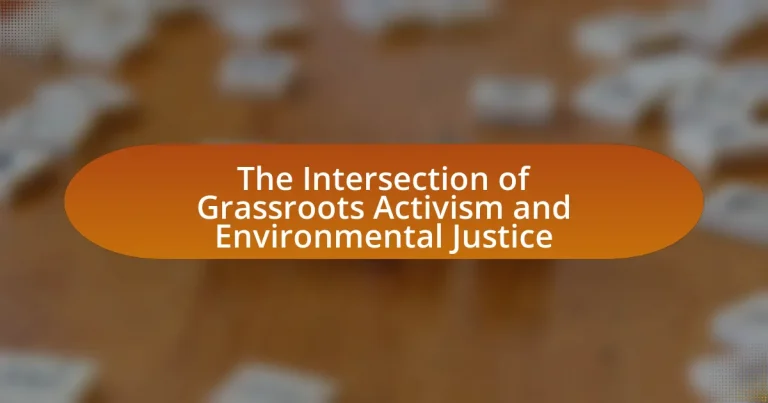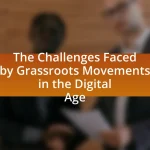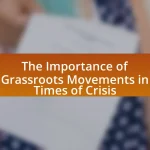The article explores the intersection of grassroots activism and environmental justice, emphasizing the collective efforts of marginalized communities to address environmental issues that disproportionately affect them. It outlines the historical roots of grassroots activism, tracing its origins to the civil rights movement and significant events like the Warren County protests in the 1980s. The article discusses how grassroots movements advocate for equitable environmental policies, influence decision-making, and empower local voices, while also highlighting the challenges they face, such as funding limitations and political opposition. Key strategies for effective grassroots activism, including community organizing and social media engagement, are examined, along with future trends in activism and practical steps individuals can take to support these efforts.
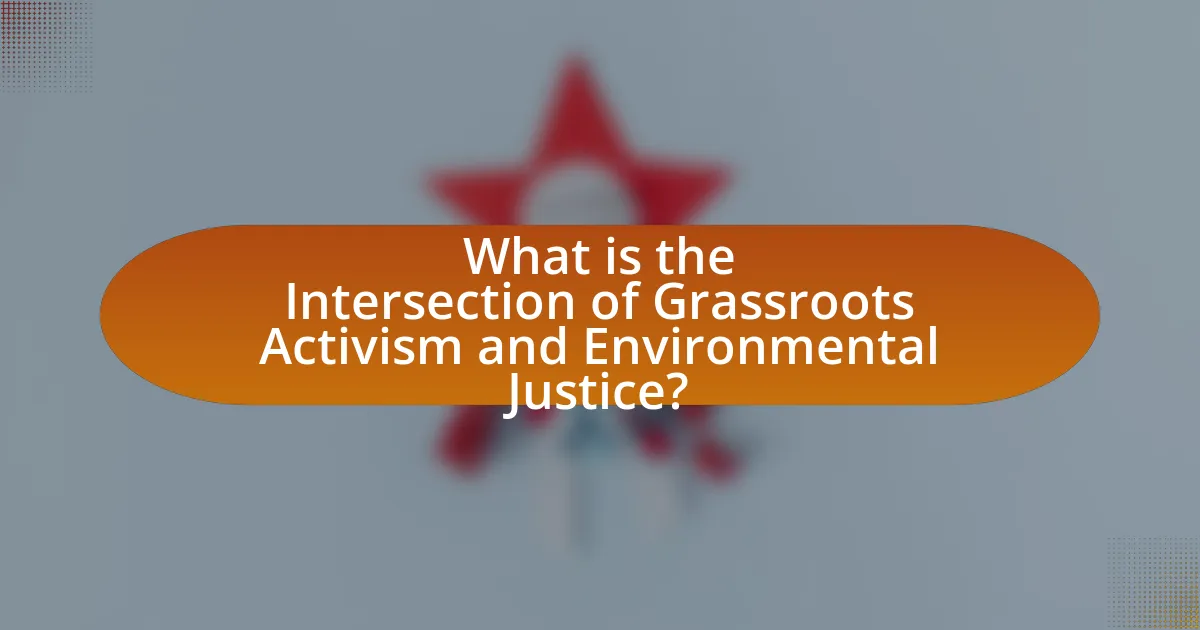
What is the Intersection of Grassroots Activism and Environmental Justice?
The intersection of grassroots activism and environmental justice lies in the collective efforts of communities to address environmental issues that disproportionately affect marginalized populations. Grassroots activism mobilizes local communities to advocate for equitable environmental policies, ensuring that the voices of those most impacted by environmental degradation are heard. For instance, the environmental justice movement emerged in the 1980s, highlighting the correlation between race, poverty, and environmental hazards, as evidenced by the 1982 protests in Warren County, North Carolina, against toxic waste dumping. This activism has led to significant policy changes, such as the establishment of the U.S. Environmental Protection Agency’s Office of Environmental Justice in 1994, which aims to address these disparities.
How do grassroots activism and environmental justice relate to each other?
Grassroots activism and environmental justice are interconnected as grassroots movements often advocate for the rights of marginalized communities disproportionately affected by environmental hazards. These movements mobilize local populations to address issues such as pollution, land use, and resource access, which are central to the principles of environmental justice. For instance, the environmental justice movement emerged in the United States during the 1980s, highlighting how low-income and minority communities faced greater exposure to toxic waste and industrial pollution. This relationship is evidenced by initiatives like the 1991 People of Color Environmental Leadership Summit, which emphasized the need for grassroots involvement in policy-making to ensure equitable environmental protections.
What are the historical roots of grassroots activism in environmental justice movements?
Grassroots activism in environmental justice movements has its historical roots in the civil rights movement of the 1960s, where marginalized communities began to advocate for their rights against environmental hazards. This activism was significantly influenced by events such as the 1969 Santa Barbara oil spill, which highlighted the disproportionate impact of environmental degradation on low-income and minority communities. The establishment of organizations like the Environmental Justice Movement in the 1980s, particularly after the 1982 protests against a hazardous waste landfill in Warren County, North Carolina, further solidified grassroots efforts. These movements emphasized the need for equitable environmental policies and the inclusion of affected communities in decision-making processes, thereby laying the groundwork for contemporary environmental justice activism.
How do grassroots activists influence environmental policy?
Grassroots activists influence environmental policy by mobilizing community engagement and advocating for sustainable practices. They raise awareness about environmental issues, often leading to increased public pressure on policymakers. For instance, the 2014 protests against the Keystone XL pipeline, organized by grassroots groups, significantly impacted the decision-making process, resulting in President Obama rejecting the project in 2015. Additionally, grassroots movements often utilize social media to amplify their messages, reaching wider audiences and fostering collective action, which can sway legislative priorities and outcomes.
Why is grassroots activism important for achieving environmental justice?
Grassroots activism is crucial for achieving environmental justice because it empowers marginalized communities to advocate for their rights and address environmental inequalities. This form of activism mobilizes local voices, ensuring that those most affected by environmental issues can influence policy decisions and hold corporations accountable. For instance, the Flint water crisis highlighted how grassroots movements can bring national attention to local environmental injustices, leading to significant policy changes and increased funding for infrastructure improvements. Additionally, studies show that grassroots efforts often lead to more equitable environmental policies, as they prioritize the needs and perspectives of underrepresented populations, thereby fostering a more inclusive approach to environmental governance.
What role do community voices play in environmental decision-making?
Community voices play a crucial role in environmental decision-making by ensuring that local perspectives and needs are considered in policies and practices. These voices contribute to more equitable outcomes by highlighting specific environmental issues that affect their communities, such as pollution or resource depletion. Research indicates that when community members engage in decision-making processes, it leads to more sustainable and effective environmental policies. For example, the 2018 report by the United Nations emphasizes the importance of local knowledge in achieving sustainable development goals, demonstrating that community involvement can enhance the relevance and effectiveness of environmental initiatives.
How does grassroots activism empower marginalized communities?
Grassroots activism empowers marginalized communities by providing them with a platform to voice their concerns and advocate for their rights. This form of activism fosters community engagement, enabling individuals to organize collectively around shared issues, such as environmental justice, which disproportionately affects marginalized groups. For instance, the environmental justice movement has seen communities of color mobilize against pollution and environmental degradation, leading to policy changes and increased awareness of their struggles. Research by the United States Environmental Protection Agency indicates that grassroots efforts have successfully influenced local environmental policies, demonstrating the tangible impact of community-led initiatives.
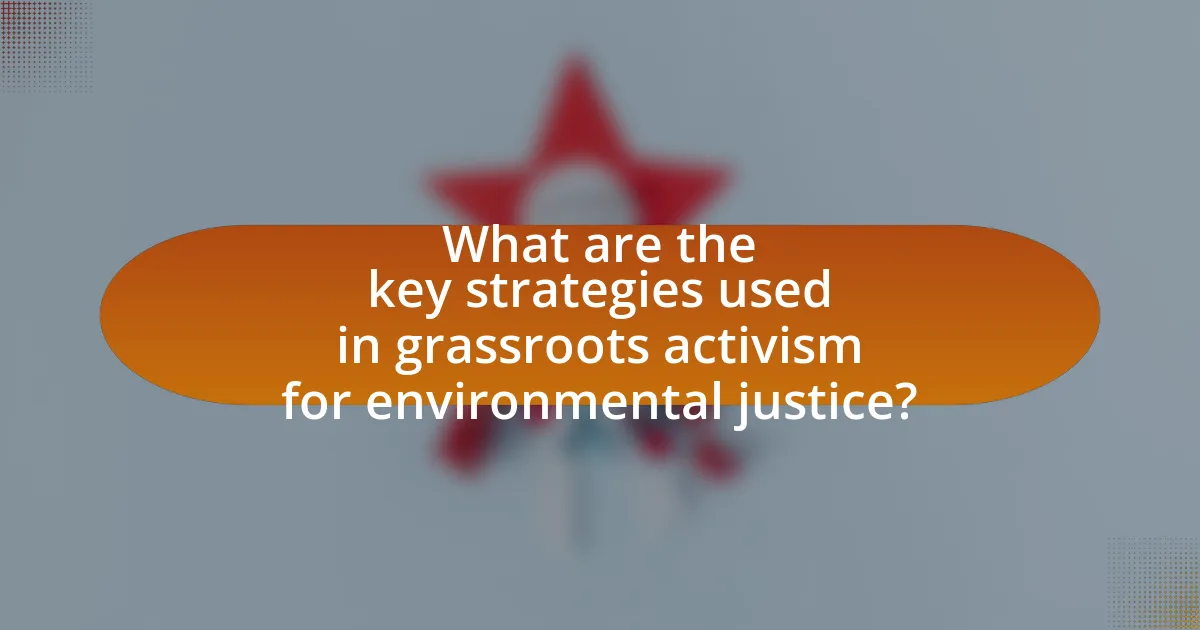
What are the key strategies used in grassroots activism for environmental justice?
Key strategies used in grassroots activism for environmental justice include community organizing, coalition building, advocacy for policy change, and public education campaigns. Community organizing empowers local residents to identify environmental issues affecting their neighborhoods, fostering collective action. Coalition building involves forming alliances with other organizations and stakeholders to amplify voices and resources, enhancing the impact of the movement. Advocacy for policy change targets local, state, and federal legislation to address environmental injustices, often utilizing data and case studies to support claims. Public education campaigns raise awareness about environmental issues and mobilize community members to participate in activism, often leveraging social media and community events to reach broader audiences. These strategies have been effective in various movements, such as the fight against toxic waste in low-income neighborhoods, demonstrating their validity in achieving environmental justice.
How do grassroots organizations mobilize communities for environmental causes?
Grassroots organizations mobilize communities for environmental causes by fostering local engagement and empowering individuals to take action. They achieve this through community education initiatives that raise awareness about environmental issues, such as pollution and climate change, and by organizing events that encourage participation, like clean-up drives and advocacy campaigns. For instance, the Sierra Club’s grassroots efforts have led to significant community involvement in conservation projects, demonstrating the effectiveness of localized activism. Additionally, these organizations often utilize social media platforms to amplify their messages and connect with a broader audience, thereby increasing community mobilization and support for environmental justice initiatives.
What methods do grassroots activists use to raise awareness about environmental issues?
Grassroots activists use various methods to raise awareness about environmental issues, including community organizing, social media campaigns, educational workshops, and public demonstrations. Community organizing involves mobilizing local residents to address environmental concerns collectively, fostering a sense of shared responsibility. Social media campaigns leverage platforms like Twitter and Facebook to disseminate information rapidly, engage a broader audience, and create viral movements. Educational workshops provide participants with knowledge about environmental issues and practical solutions, empowering them to take action. Public demonstrations, such as marches and rallies, visually represent the urgency of environmental issues and attract media attention, amplifying the message. These methods have proven effective in raising awareness and mobilizing communities around environmental justice initiatives.
How do grassroots campaigns leverage social media for activism?
Grassroots campaigns leverage social media for activism by utilizing platforms to mobilize supporters, disseminate information, and foster community engagement. These campaigns create targeted content that resonates with specific audiences, often using hashtags and viral challenges to increase visibility and participation. For instance, the #BlackLivesMatter movement effectively used Twitter and Instagram to raise awareness about racial injustice, leading to widespread protests and policy discussions. Additionally, social media analytics allow grassroots organizations to track engagement and adapt strategies in real-time, enhancing their outreach efforts. This approach has proven effective, as studies show that social media can significantly amplify the reach of grassroots messages, mobilizing thousands for causes like climate action and social justice.
What challenges do grassroots activists face in the pursuit of environmental justice?
Grassroots activists face significant challenges in the pursuit of environmental justice, primarily including limited funding, lack of access to decision-making processes, and systemic opposition from powerful entities. Limited funding restricts their ability to mobilize resources, conduct research, and sustain long-term campaigns, which is critical for addressing complex environmental issues. Additionally, grassroots activists often lack representation in governmental and corporate decision-making, making it difficult to influence policies that affect their communities. Systemic opposition from industries and governments, which may prioritize economic interests over environmental concerns, further complicates their efforts. For instance, a report by the Environmental Justice Foundation highlights that marginalized communities frequently encounter resistance when advocating for their rights, illustrating the uphill battle grassroots activists face in achieving environmental justice.
How do funding and resource limitations impact grassroots movements?
Funding and resource limitations significantly hinder grassroots movements by restricting their ability to mobilize, organize, and sustain efforts. Without adequate financial support, these movements struggle to cover essential costs such as outreach, materials, and event logistics, which are crucial for raising awareness and engaging the community. For instance, a study by the Grassroots Fundraising Journal found that organizations with limited funding often face challenges in maintaining staff and volunteer engagement, leading to decreased effectiveness in advocacy efforts. Additionally, resource constraints can limit access to technology and communication tools, further isolating grassroots movements from broader networks and potential allies. This lack of resources ultimately diminishes their impact on policy change and community mobilization, as evidenced by the challenges faced by numerous environmental justice initiatives that rely heavily on grassroots support but lack sufficient funding to scale their efforts.
What are the legal and political obstacles to grassroots activism?
Legal and political obstacles to grassroots activism include restrictive laws, bureaucratic hurdles, and political opposition. For instance, many jurisdictions impose regulations that limit the ability of grassroots organizations to mobilize, such as requiring permits for protests or restricting access to public spaces. Additionally, political entities may actively oppose grassroots movements, using tactics such as defunding, surveillance, or legal challenges to undermine their efforts. A notable example is the use of anti-protest laws in various states, which have been enacted to deter activism by imposing severe penalties for civil disobedience. These obstacles can significantly hinder the effectiveness and reach of grassroots initiatives aimed at promoting environmental justice.
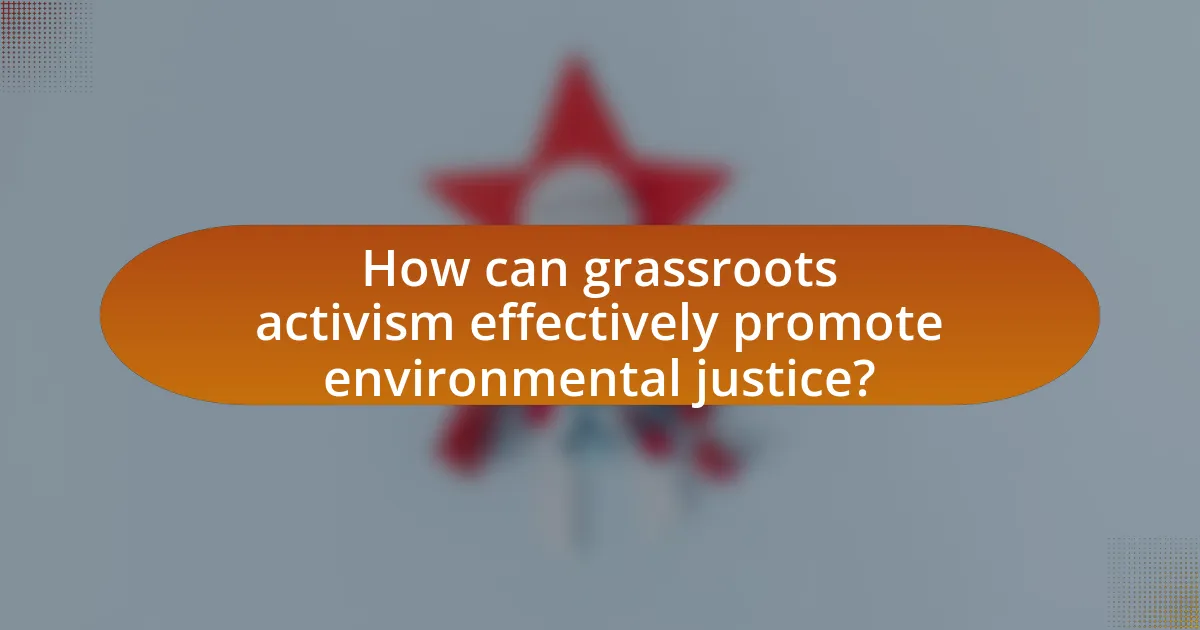
How can grassroots activism effectively promote environmental justice?
Grassroots activism can effectively promote environmental justice by mobilizing communities to advocate for equitable environmental policies and practices. This form of activism empowers marginalized groups, enabling them to voice their concerns about environmental hazards disproportionately affecting their neighborhoods. For instance, organizations like the Environmental Justice Movement have successfully highlighted issues such as toxic waste disposal in low-income areas, leading to policy changes and increased regulatory scrutiny. Research indicates that grassroots efforts can result in significant legislative outcomes, as seen in the 1994 Executive Order 12898, which aimed to address environmental justice in federal agencies, largely influenced by grassroots advocacy.
What best practices can grassroots organizations adopt for successful activism?
Grassroots organizations can adopt several best practices for successful activism, including building strong community relationships, utilizing social media effectively, and engaging in coalition-building. Strong community relationships foster trust and collaboration, which are essential for mobilizing support and resources. For instance, organizations like the Sierra Club have successfully engaged local communities to advocate for environmental justice by prioritizing their needs and concerns.
Utilizing social media allows grassroots organizations to amplify their message and reach a broader audience quickly. The #BlackLivesMatter movement exemplifies how social media can mobilize support and raise awareness about social issues, demonstrating its effectiveness in grassroots activism.
Engaging in coalition-building with other organizations enhances resources and expertise, creating a more significant impact. The collaboration between various environmental justice groups during the 2017 People’s Climate March showcased how collective action can lead to increased visibility and influence in policy discussions. These practices are supported by evidence from successful grassroots movements that have effectively addressed social and environmental issues.
How can collaboration with other organizations enhance grassroots efforts?
Collaboration with other organizations can enhance grassroots efforts by pooling resources, expertise, and networks to amplify impact. When grassroots organizations partner with established entities, they gain access to funding, training, and broader outreach capabilities, which can significantly increase their effectiveness. For instance, a study by the National Council of Nonprofits highlights that collaborative initiatives often lead to increased visibility and credibility, enabling grassroots movements to attract more supporters and resources. This synergy not only strengthens the grassroots initiatives but also fosters a more unified approach to addressing environmental justice issues, ultimately leading to more sustainable outcomes.
What role does education and training play in strengthening grassroots movements?
Education and training are crucial in strengthening grassroots movements by equipping individuals with the knowledge and skills necessary to advocate effectively for their causes. These educational initiatives foster awareness of social, political, and environmental issues, enabling participants to understand the complexities of their challenges. For instance, programs that teach community organizing, public speaking, and policy analysis empower activists to mobilize support and influence decision-makers. Research indicates that grassroots organizations with trained leaders are more successful in achieving their objectives, as evidenced by the success of the Civil Rights Movement, where education played a pivotal role in developing effective strategies and mobilizing communities.
What are the future trends in grassroots activism and environmental justice?
Future trends in grassroots activism and environmental justice include increased digital mobilization, intersectionality in advocacy, and a focus on local solutions. Digital platforms enable activists to reach wider audiences and organize more effectively, as seen in movements like Fridays for Future, which gained global traction through social media. Intersectionality is becoming crucial as activists recognize the interconnectedness of social justice issues, leading to more inclusive coalitions that address systemic inequalities. Additionally, there is a growing emphasis on localized environmental solutions, as communities advocate for tailored approaches that reflect their unique challenges and resources, exemplified by community-led initiatives in urban areas addressing pollution and access to green spaces. These trends indicate a shift towards more collaborative, technology-driven, and community-focused activism in the pursuit of environmental justice.
How is technology shaping the future of grassroots activism?
Technology is significantly shaping the future of grassroots activism by enhancing communication, mobilization, and fundraising capabilities. Digital platforms enable activists to reach wider audiences quickly, facilitating the organization of events and campaigns through social media channels like Twitter and Facebook, which have been pivotal in movements such as Black Lives Matter and climate strikes. Additionally, crowdfunding platforms like GoFundMe allow grassroots organizations to secure financial support directly from their communities, increasing their operational capacity. According to a 2020 report by the Pew Research Center, 69% of Americans believe social media is an effective tool for activism, highlighting its role in shaping public discourse and engagement.
What emerging issues are grassroots activists likely to address in the coming years?
Grassroots activists are likely to address climate change adaptation and resilience in the coming years. As extreme weather events become more frequent and severe, communities will increasingly demand local solutions to mitigate the impacts of climate change. For instance, grassroots movements have already mobilized around issues such as urban heat islands and flooding, advocating for green infrastructure and sustainable urban planning. Additionally, activists will focus on environmental justice, ensuring that marginalized communities disproportionately affected by pollution and climate change receive equitable resources and support. This focus is supported by studies indicating that low-income and minority communities face higher exposure to environmental hazards, necessitating targeted grassroots efforts to address these disparities.
What practical steps can individuals take to support grassroots activism for environmental justice?
Individuals can support grassroots activism for environmental justice by actively participating in local initiatives, such as community clean-up events and advocacy campaigns. Engaging in these activities helps raise awareness about environmental issues affecting marginalized communities. Additionally, individuals can donate to or volunteer with organizations focused on environmental justice, which often rely on grassroots support to amplify their efforts. Research indicates that grassroots movements can effectively influence policy changes; for instance, the 2017 People’s Climate March mobilized over 200,000 participants, demonstrating the power of collective action in advocating for environmental reforms. By sharing information on social media and encouraging others to join these efforts, individuals can further expand the reach and impact of grassroots activism.
